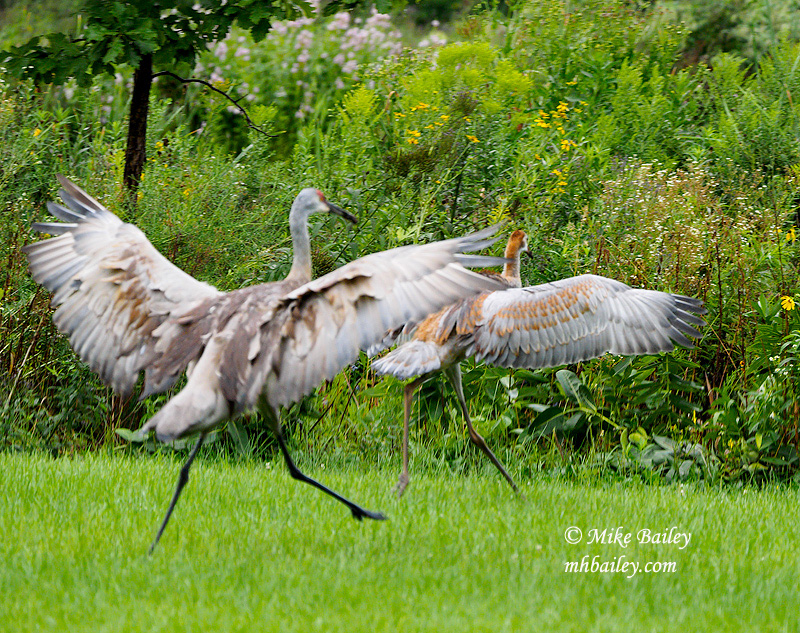
Sandhill Crane Despite a very wet couple of days at the end of the week, the juvenile felt full of energy. |

Sandhill Crane Feathers ruffled more from excitement than anything else. Always something to be excited about. |

Sandhill Crane Wing flapping while running takes up more and more of the time. |

Sandhill Crane Being wet excites the parents much less. |

Sandhill Crane Droopy wings seem to express the mood. |

Sandhill Crane For the juvenile the sky is more interesting by the hour. Something up there calls. |

Sandhill Crane And this is what it is. Another run with an impressive display of the fine wings. |

Sandhill Crane The wings have taken on a life of their own, not wanting to be tucked back in. They need to be used. |

Sandhill Crane With all the rain, foraging has become more difficult since the mud sticks readily to the probing bills. |

Sandhill Crane Despite the juvenile being almost as large as the parents, the parents continue to offer food. Fuel. |

Sandhill Crane Side by side for comparison. Almost there. The tail feathers have not quite kept up yet. |

Sandhill Crane Being the center of the universe for its entire life of barely two months might make socializing outside the family difficult. |

Sandhill Crane The ability to stand on one leg is coming along nicely too. |

Sandhill Crane Things stick to the bill with all the mud glue, requiring a careful cleaning with the foot. |

Sandhill Crane Sharing worm parts. |

Sandhill Crane Enough of eating, time for more flapping practice. |

Sandhill Crane After a run ahead of the parents, the juvenile pauses and stares for the longest time at the pond and beckoning sky. |

Sandhill Crane And off again, full of steam and enthusiasm and need. |

Sandhill Crane A near collison with the flowers and weeds as an excited parent follows along with the almost flight. |

Sandhill Crane Flapping, flapping, standing tall. Are the parents aware of how close the juvenile is to making it up into the air? |

Sandhill Crane More food, but the offer seems as reluctant as the demand is strong. |

Sandhill Crane Emerging from the vegetation into the open, the juvenile does a couple of good, strong flaps. |

Sandhill Crane And a little lift-off, across the walkway, but not a lot of elevation. |

Sandhill Crane Still airborne, another flap or two, another few feet. |

Sandhill Crane Mid-flight, in the air, coasting. |

Sandhill Crane And touch-down, a huge flight of ten or twelve feet. The neck feathers start to ruffle from the excitement of it all. |

Sandhill Crane Finishing up and a full ruffling of the feathers. A good start. |

Sandhill Crane That calls for one thing to express the vast thrill of it all. A quick squat and poop. Something had to give. |

Sandhill Crane Back to business as usual. The juvenile's wings will not stay put. One parent echoes some of the excitement. |
© Michael Bailey All Rights Reserved; Not for reproduction.
No photograph from this blog may be reproduced or used
in any form or by any means whatsover.























